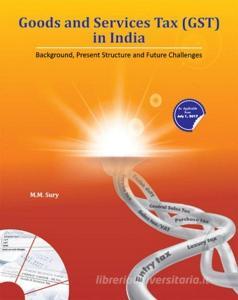
Goods & Services Tax (GST) in India
Background, Present Structure & Future Challenges
- Editore:
New Century Publications
- EAN:
9788177084573
- ISBN:
8177084577
- Pagine:
- 246
- Formato:
- Hardback
- Lingua:
- Inglese
Descrizione Goods & Services Tax (GST) in India
The recently introduced Goods and Services Tax (GST) is undoubtedly the biggest tax reform in the fiscal history of India. After missing several deadlines and overcoming almost a decade of political differences -- on how to replace a multi-layered set of Central and State taxes and levies with a uniform nationwide tax -- GST finally saw the light of day on July 1, 2017. Implementation of GST leaves behind an inefficient, complicated and fragmented indirect tax system. GST has subsumed a profusion of Central and State indirect taxes to create a single unified market. It is slated to make India a seamless national market, boosting trade and industry and, in turn, growth rate. GST is expected to represent a leap forward in creating a much cleaner dual VAT. Common base and common rates -- across goods and services and across States and between Centre and States -- will facilitate administration and improve compliance while also rendering manageable the collection of taxes on inter-State sales. By amalgamating a large number of Central and State taxes into a single tax and allowing set-off of prior-stage taxes, it would mitigate the ill effects of cascading or pyramiding and pave the way for a common national market. Introduction of GST would also make Indias products competitive in the domestic and international markets. It will help improve governance, strengthen tax institutions, facilitate Make-in-India by Making-One-India, and impart buoyancy to the tax base. GST is not merely a tax reform. It is also a reform that will revolutionise the way business is conducted in India. Signifying the spirit of co-operative federalism, GST is a historic and game-changing tax reform. It is 21st centurys global standard for VAT in large federal systems. Switching over to GST is fraught with many problems -- administrative and technical. However, such problems are endemic to any change of revolutionary proportions. The euphoria created by GST is understandable. It is a new tax shrouded in mystery. Stakeholders -- State Governments, tax officials, manufacturers, traders, third parties and consumers -- are apprehensive, anxious and uncertain about its implications. GST is like an elephant amidst blind men, each holding a part of it and wondering what it is! It is human nature to resist change because change involves problems, readjustments and additional efforts. Every horse resists the placing of a saddle on its back, but once it is there it prepares itself to run for the rider. Status quo is always cosy but it has deleterious effects in the long-run, particularly in the context of societies. This book explains and examines various aspects of GST, in simple, lucid and non-technical language, for the benefit of a cross-section of readers including teachers and students of economics, commerce, law, public administration, business management, and chartered accountancy. It will also serve the needs of legislators, business executives, entrepreneurs and investors, and others interested in understanding the basics of GST.

